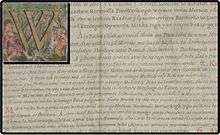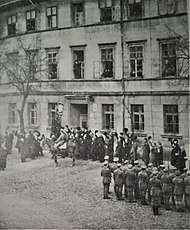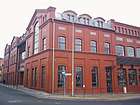Pleszew
Pleszew ([ˈplɛʂɛf]; German: Pleschen) is a town in Poland, in Greater Poland Voivodeship, about 90 km southeast of Poznań. It is the capital of Pleszew County (powiat pleszewski). Population is 17,892 (2004).
Pleszew | |
|---|---|
 Town hall | |
 Flag  Coat of arms | |
 Pleszew | |
| Coordinates: 51°53′N 17°47′E | |
| Country | |
| Voivodeship | Greater Poland |
| County | Pleszew County |
| Gmina | Gmina Pleszew |
| Town rights | 1283 |
| Government | |
| • Mayor | Arkadiusz Ptak |
| Area | |
| • Total | 13.19 km2 (5.09 sq mi) |
| Population (2006) | |
| • Total | 17,787 |
| • Density | 1,300/km2 (3,500/sq mi) |
| Time zone | UTC+1 (CET) |
| • Summer (DST) | UTC+2 (CEST) |
| Postal code | 63-300 |
| Area code(s) | +48 62 |
| Car plates | PPL |
| Climate | Dfb |
| Website | http://www.pleszew.pl/ |
History

The oldest permanent human settlements in the present-day Pleszew and its surroundings date back to the 9th century BC.[1] The oldest known mention of Pleszew, already as a town, comes from a 1283 document of - in the document of Duke and future King of Poland Przemysł II of the Piast dynasty.[1] In the following centuries it was a private town owned by Polish nobility, located in the Kalisz Voivodeship in the Greater Poland Province of the Polish Crown. King John I Albert in the privilege of 1493 permitted the organization of two weekly markets and two annual fairs.[1] In the early 16th century, there were nine craft guilds in the town.[1] Pleszew was a local center of Reformation. In the 18th century, one of two main routes connecting Warsaw and Dresden ran through Pleszew and Kings Augustus II the Strong and Augustus III of Poland traveled that route numerous times.[2]

During the First Partition of Poland, in 1793, Pleszew was annexed by Prussia.[1] It was regained by Poles as part of the short-lived Duchy of Warsaw in 1807, before it was re-annexed by Prussia in 1815. It was an important center of the unsuccessful Polish Greater Poland uprising (1848).[1] In the following decades, to resist Germanisation, Poles founded various organizations, including agricultural, industrial and educational societies, the Cooperative Bank (Bank Spółdzielczy.), a printing house, scout troops and a local branch of the "Sokół" Polish Gymnastic Society.[1] In the second half of the 19th century, new industrial factories were established.[1] Many inhabitants took part in the Greater Poland uprising (1918–19), which aim was to reintegrate the town along with the region of Greater Poland with Poland, after the country regained independence in 1918. The Poles took control of the city in January 1919.
On the day of the German invasion of Poland (World War II), on September 1, Germany unsuccessfully raided Polish military barracks, killing 13 civilians.[1] Wehrmacht troops entered the town a week later. During the German occupation of Poland, the Polish population was subject to mass arrests, executions and expulsions. Shortly after capturing the town, the Germans established a prison for Polish people in the town.[3] During the Intelligenzaktion, in October 1939, the Germans executed 7 Poles in the Boreczek forest.[4] Another 68 Poles were killed in the prison, and 8 Poles were murdered at the Gestapo station.[5] Nevertheless, the Polish resistance movement in Pleszew was organized already in October 1939.[1] The town was captured by the Soviets in January 1945, and was soon restored to Poland.
In 1983 the 700th anniversary of Pleszew was celebrated,[1] in reference to the first known historical mention of the town in 1283.
Sights
Among the historic sights of Pleszew are the Market Square (Rynek) with the Town Hall (Ratusz), the Regional Museum, the churches of Beheading of Saint John the Baptist, of Saint Florian and of the Holy Savior, and other historic buildings, including headquarters of historic organizations, townhouses and schools. There also numerous memorials at the sites of killings of Poles carried out by the Germans during the occupation of Poland.
 High school
High school Church of the Beheading of Saint John the Baptist
Church of the Beheading of Saint John the Baptist.jpg) Memorial stone in the Boreczek forest at the site of a German execution of 7 Poles in 1939
Memorial stone in the Boreczek forest at the site of a German execution of 7 Poles in 1939 Shopping mall
Shopping mall
People
- Hugo Leichtentritt (1874, here - 1951), a German Jewish musicologist and composer
- Hanna Suchocka (born 1946, here), first female Prime Minister of Poland
- Sergiusz Prusak (born 1979, here), a Polish footballer
- Maciej Piaszczyński (born 1989, here), a Polish international speedway rider
- Agnieszka (Lipska) Baranowska (1819–1890), a Polish playwright and poet, wrote several plays for this town's local theater
- Moses Samuel Zuckermandl (1836, Uherský Brod - 1917), a Czech-German rabbi, lived here
- Stefan Pawlicki (1839, Gdańsk - 1916), a Polish Catholic priest, philosopher, historian of philosophy; lived here
- Emil Jarrow (Javorzynski) (born 1876, here - 1959), world touring vaudeville magician and comedian.
- Teodor Jeske-Choiński (27 February 1854 - 14 April 1920 ) was a Polish intellectual, writer and historian, literature critic
International relations
Twin towns — Sister cities
Pleszew is twinned with:
See also
References
- "Skrót dziejów miasta". Pleszew.pl (in Polish). Retrieved 1 March 2020.
- "Informacja historyczna". Dresden-Warszawa (in Polish). Retrieved 1 March 2020.
- Maria Wardzyńska, Był rok 1939. Operacja niemieckiej policji bezpieczeństwa w Polsce. Intelligenzaktion, IPN, Warszawa, 2009, p. 117 (in Polish)
- Wardzyńska, Op. cit., p. 201
- "Na pleszewskich grobach zapłonął Znicz Pamięci". Pleszew Nasze Miasto (in Polish). Retrieved 1 March 2020.
